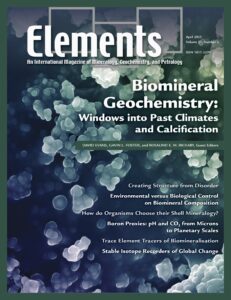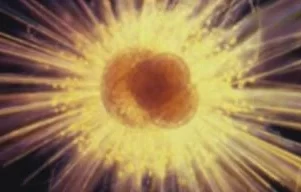Biomineral Geochemistry: Windows into Past Climates and Calcification
David Evans, Gavin L. Foster, and Rosalind E. M. Rickaby– Guest Editors
Table of Contents
Marine calcium carbonate biominerals, especially the shells and skeletons produced by molluscs, corals, and the immeasurably numerous calcifying phytoplankton and zooplankton, are of both societal and environmental importance for two key reasons. Firstly, the mineralised remains of these organisms are one of the largest longterm sinks of carbon on Earth’s surface. Secondly, and perhaps more practically, the (trace) element and isotopic composition of these biominerals probably represents the most widely applied tool for quantitatively reconstructing past environmental conditions on timescales from days to millions of years. It has been known for some time that the processes of biomineralisation imprint on these ‘proxy’ systems, shifting their behaviour away from thermodynamic equilibrium, such that they typically require empirical calibration to an environmental variable of interest. The generally poor understanding of the physics and chemistry of these biomineralisation processes therefore introduces uncertainty both into our palaeo reconstructions and provides significant limits to our ability to accurately predict the future response of the marine carbon cycle to anthropogenic ocean acidification. However, it has recently become apparent that this biological imprint also offers a unique opportunity—skeletal and shell geochemical information can be leveraged to constrain various aspects of physiology including the biomineralisation process to noninvasively understand the organisms themselves. In this issue of Elements, a series of articles showcase how low temperature proxy systems can offer insights into both paleoenvironmental change, as well as the mechanistic processes involved in biomineral formation. Ultimately, our aim is to highlight how the two fields could be more closely connected via research into the controls on biomineral chemistry.
- Geochemical Proxy Systems in Marine CaCO3 Biominerals Record Both Environmental Changes and Biomineralisation Processes
- Controls on CaCO3 Polymorphism: From Laboratory Precipitation to Biomineralization across Geological Time
- Boron Proxies: From Calcification Site pH to Cenozoic pCO2
- Calcium Carbonate Biomineralisation: Insights from Trace Elements
- Oxygen and Carbon Isotopes in Marine Carbonates: A Biogenic Climate Archive Built Upon Disequilibria
- Amorphous Intermediate Phases: A Major Contribution to the ‘Vital Effect’?
GREENALITE
Guest Editors: Birger Rasmussen (The University of Western Australia), Janet R. Muhling (The University of Western Australia), and Nicholas J. Tosca (University of Cambridge, UK)
Greenalite [Fe3Si2O5(OH)4] is an Fe(II)-serpentine mineral that was first identified in Lake Superior iron formations over 100 years ago, but its true extent is only now being recognized with the advent of in-situ nanoscale techniques. In the last decade, nanoparticulate greenalite has emerged as a prime candidate in the deposition of early Precambrian banded iron formations (BIFs). Together with experiments and modeling, new light is being shed on greenalite-forming conditions and environments, challenging long-held models that argue that BIFs were deposited from seawater as biologically oxidized phases of Fe. Greenalite–hisingerite minerals also occur as alteration products in meteorites, and recent in-situ and orbital data imply that Fe-serpentines are major products of serpentinization systems on early Mars, potentially recording widespread H2 production.
- Greenalite: A Tiny Crystal with a Big Story Birger Rasmussen (The University of Western Australia), Janet R. Muhling (The University of Western Australia), and Nicholas J. Tosca (University of Cambridge, UK)
- Ordered but Disordered: The Peculiar Crystal Structure of Greenalite Huifang Xu (University of Wisconsin-Madison, USA), Yiping Yang (Guangzhou Institute of Geochemistry, China), and Stephen Guggenheim (University of Illinois at Chicago, USA)
- Serpentine Solid Solutions and Hydrogen Production on Early Earth and Mars Benjamin M. Tutolo (University of Calgary, Canada) and James A. Leong (Miami University, USA)
- Greenalite: Cryptic Mineral of Ancient Ferruginous Oceans Janet R. Muhling (The University of Western Australia), Latisha A. Brengman (University of Minnesota-Duluth, USA), and Jena E. Johnson (University of Michigan, USA)
- The Precambrian Greenalite Factory Nicholas J. Tosca (University of Cambridge, UK), Clancy Zhijian Jiang (University of Cambridge, England), and Benjamin M. Tutolo (University of Calgary, Canada)
- Greenalite: A Template Fit for Life? Birger Rasmussen (The University of Western Australia), Woodward W. Fischer (California Institute of Technology, USA), and Daniel Duzdevich (The University of Chicago, USA)
- Birth and Growth of Minerals from Aqueous Solutions (February 2025)
- Biomineral Geochemistry: Windows into Past Climates and Calcification (April 2025)
- Greenalite – A Tiny Crystal with a Big Story (June 2025)
- Re-Os – Clock With Clout (August 2025)
- Sample Return Throughout the Ages (October 2025)
- The Variscan Orogeny in Europe – Understanding Supercontinent Formation (December 2025)













